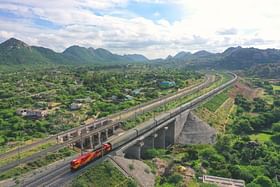The Vadodara division of the Dedicated Freight Corridor Corporation of India Limited (DFCCIL) is actively engaged in the development of freight terminals at railway stations, strategically positioned to cater to the nearby industrial freight needs.
According to Manish Gupta, the General Manager of Coordination at DFCCIL in Vadodara, they have identified potential locations for these terminals, including Makarpura, Varedia, New Sanjali, New Gothan, and New Udhana, and the tendering process is already underway.
In addition, they are making efforts to establish an environmentally friendly corridor that extends from Jawaharlal Nehru Port Terminal (JNPT) in Mumbai to Dadri. To achieve this, they plan to incorporate solar energy systems at many stations to make them energy-neutral.
As part of their ongoing progress, they have initiated the trial run of goods trains on the newly electrified railway section connecting Gothangam to Makarpura, covering a 115km stretch.
This new railway section spans 135km and passes through the Surat, Bharuch, and Vadodara districts in Gujarat. They anticipate regular operations of double-stack goods trains on this route within the current financial year, reports the Economic Times.
Furthermore, the Vadodara unit has received recognition for its outstanding performance, being awarded the Running Efficiency Shield for the year 2022-23 for the first time.
This shield acknowledges the unit’s commitment to innovative initiatives as it actively works towards completing the remaining tasks on the Western Dedicated Freight Corridor (WDFC).
Gupta highlighted some of the unit’s notable initiatives, such as implementing a transition system using geocell technology in bridge approaches, introducing various innovative bridge protection methods, and enhancing slope protection work, among other accomplishments.
Dedicated Freight Corridors
Prime Minister Narendra Modi inaugurated the DFC network on 12 December 2020, hailing it as a game changer for India in the twenty first century and a catalyst for rapid national development.
The DFC project is strategically aligned with the National Rail Plan, which sets a bold objective: to increase the railway’s modal share in India from the existing 28 per cent to an impressive 44 per cent by the year 2051.
Crucially, the DFC is not just a railway project; it’s a linchpin of the National Logistics Policy, aiming to reduce logistics costs from the current 15 per cent of GDP to a more sustainable 8 per cent by 2030.
Furthermore, the DFC’s capacity expansion is instrumental in realising Indian Railways’ ambitious objective of achieving a freight loading capacity of 3,000 MT by 2030.
By streamlining freight transportation, the DFC plays a pivotal role in achieving this goal, making the movement of goods more efficient, cost-effective, and reliable.
Western Dedicated Freight Corridor (WDFC)
The WDFC, connecting Dadri in Uttar Pradesh to Jawaharlal Nehru Port (JNPT) in Mumbai, passes through five states UP, Haryana, Rajasthan, Gujarat, and Maharashtra.
The western corridor covers a distance of 1,504 km through a double-line electric (2 x 25 KV) track from JNPT to Dadri via Vadodara-Ahmedabad-Palanpur-Phulera-Rewari. The Western DFC is proposed to join the Eastern DFC at Dadri.
Western DFC would mainly cover Rajasthan (565 km), Maharashtra (177 km), Gujarat (565 km) Haryana (177 km) and about 18 km in Uttar Pradesh.
Alignment has been generally kept parallel to existing lines except provision of detours at Diva, Surat, Ankleshwar, Bharuch, Vadodara, Anand, Ahmedabad, Palanpur, Phulera and Rewari. However, it is entirely on a new alignment from Rewari to Dadri.


